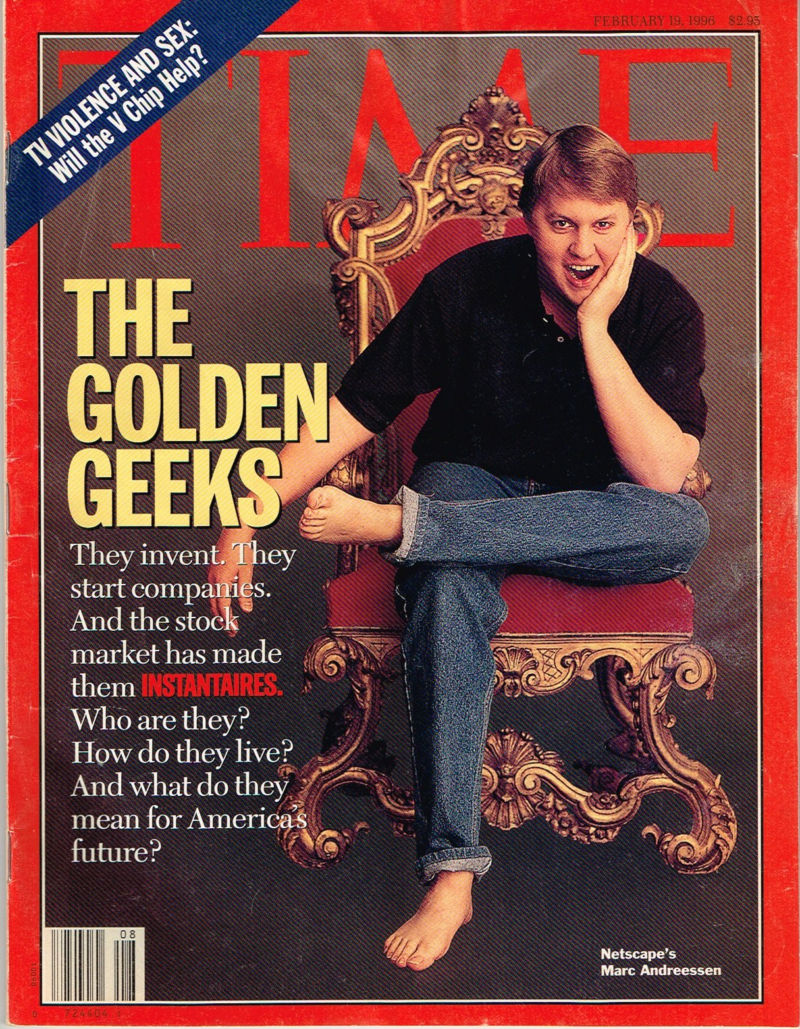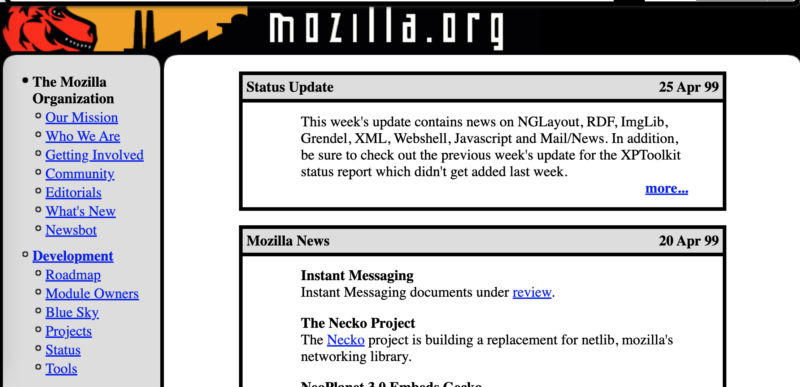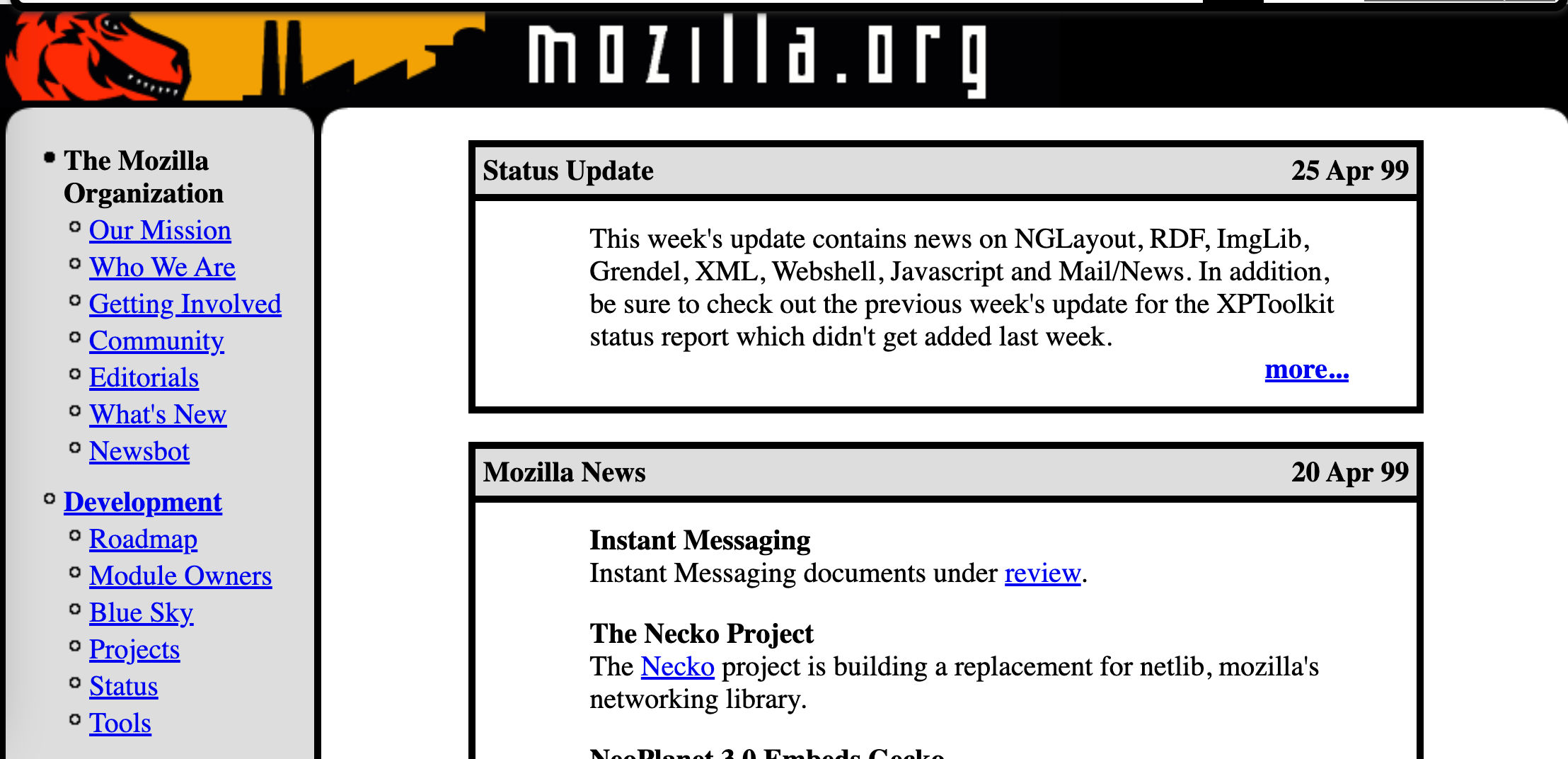In 1997, Netscape had already decided it was done with its browser.
The browser in question, Netscape Navigator, had rocketed the company to the largest IPO in history. Its founders and engineers were media darlings. They were David to Microsoft’s Goliath; the companies bullish co-founder, Marc Andreessen was even billed as “the next Bill Gates. The boldest among the tech future-tellers were predicting the end of Microsoft—at the hands of Netscape.

But Microsoft was not going to go down easy. At the end of 1995, they had officially entered the browser market with Internet Explorer. By 1997, they were actually gaining on Netscape.
Feeling the pressure, Netscape CEO James Barksdale and Andreessen—who as a sort of company visionary and spokesperson had become a symbolic figurehead of Netscape’s upstart, devil-may-care ambition—turned their company on a dime. The new target: groupware, or what would eventually be known as intranets.
Groupware was big business. The most successful competitor was Lotus Notes, who had just been acquired by IBM for 3.5 billion dollars in cash. Groupware software was installed on the computers of employees of large corporations. It allowed team members to share project information, document progress, manage email and contacts, synchronize calendars, and a lot more all in one software package through a series of connected tools. This software needed to be installed on the computer of every employee, to give them access to this shared information. It was laborious, at times, but allowed companies to stay in control of discussions and knowledge sharing.
Executives at Netscape recognized the potential windfall of the groupware market, and the market fit with their existing browser. The original intent of the web—created to share notes and directory information at the CERN research lab—largely reflects the needs of large businesses through groupware. They need an easy to way to store, publish and distribute information across their organization, and connect people simply and easily. The web was easy to use, easy to install, and pennies on the dollar for the next lowest-costing groupware software. If it could bridge the gap with a few well-timed features, it could take the place of an internal internet, the intranet.
In fact, some companies were already using licensed copies of the Netscape browser and web server to manage their intranets. Recognizing greater opportunity, Netscape became more deliberate in targeting the market. They acquired Collabra Share, a former competitor in the groupware space, and folded it into their platform.
With the release of a newly rebranded and renamed Netscape Communicator in the summer of 1997, the company had completed its pivot. Communicator was a swiss-army toolset for corporations. Bundled into the browser was an email client, a Collabra-backed discussion forum, calendar, address book, HTML publishing capabilities, and more features companies had come to expect from groupware.

It rapidly closed the gap that remained in the groupware market. And more importantly, it boosted sales. Corporate customers wanting to be out on the bleeding edge of technology flooded Netscape with calls. They weren’t able to carve a significant share of the multi-billion dollar groupware market, but an influx of enterprise sales across the industry was more than enough to keep Netscape afloat. And the rapid influx of sales improved their standing, and their stock price, on Wall Street.
The browser became less of a focus. Netscape spent its time and money on additional features for the intranet. When Andreessen strode on stage of the second Netscape Developer Conference in October of 1996 he didn’t talk about the browser, released less than a couple of years prior, that had made him famous. He declared 1996 the rise of the intranet, and 1997 the year of Netscape groupware. It was a clear signal; Netscape was ready to play in the big leagues. By the end of 1998, Netscape would leverage its profits from the intranet in a 4 billion dollar acquisition by AOL.
Netscape’s lean into the groupware market bought them valuable time. Time enough to hold Microsoft off. Time enough to invent a bold new and centralized product line developed for the needs of the enterprise. Time enough for the developers of the Netscape browser—a browser that had more or less become a distraction not entirely essential to the companies bottom line—to convince upper management to try something new, and relatively unprecedented.
Just as Netscape was riding the wave of the intranet, engineer Frank Hecker began circulating a whitepaper inside of Netscape. In it, he encourages the company to do something relatively simple: release their browser for free for everyone, and, more surprisingly, open source its code for public contributions. The browser was languishing, Hecker suggested in the whitepaper. Citing the widely circulated polemic by Eric Raymond called The Cathedral and the Bazaar, Hecker argued that freeing the source code of Netscape would help it develop more rapidly, patch bugs more quickly, and develop features that could actually compete with a tech giant like Microsoft.
Hecker was joined internally by Chief Technology Officer Eric Hahn and free software advocate and one of the original Netscape engineers Jamie Zawinski. By the beginning of 1998, they had made their case all the way up the chain, to Barksdale and Andreessen. And just about everyone was convinced it was the right move.
In January of 1998, Netscape announced that the Netscape browser would be open sourced by April under the umbrella project known as Mozilla. This led to the creation of the Mozilla organization, spun out from Netscape; a wholly independent entity to maintain the new open source version of the browser.

Mozilla would be beset with problems almost as soon as it began. It would sputter and start for years, undergoing in-fighting and massive code rewrites that would stall development. Netscape 5 would be completely abandoned before it was ever released. During that time, Microsoft would take over a lion’s share of the market. The web would go mostly stagnant.
That is, until 2002, when Mozilla finally released the first version of their browser, Mozilla Firefox. (somewhat amusingly, it was almost called Phoenix). Firefox was the jolt the web needed. It would once again awaken feature development in browsers, and as it began to eat away from Microsoft’s market share, Microsoft would be forced to once again come to the table and begin developing new web standards.
Without Firefox, the web may may have become a monolith under Microsoft’s control. It demonstrated the practical value of free software on a large and ubiquitous decentralized web. And without the intranet—both the revenues it generated for Netscape and the distraction from the browser that subsequently created—there wouldn’t be a Firefox.

